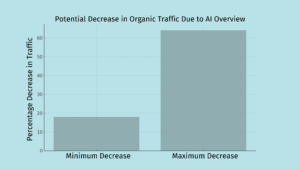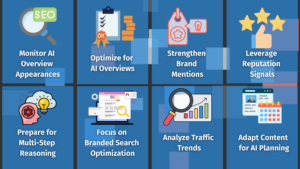Google’s AI Overviews: What Marketers Need to Know
As Google continues to innovate in the search space, its newly rebranded AI feature, previously known as the Search Generative Experience (SGE), has officially been rolled out as AI Overviews. This change is crucial for marketers, publishers, and website owners because it significantly transforms how search results are shown and how users interact with them.
What Are AI Overviews?
Google’s AI Overviews now appear at the very top of search results, functioning as concise, AI-generated summaries that pull from various online sources to answer a user’s query. These overviews distill vast amounts of information into digestible snapshots, giving users the ability to quickly access essential details. However, traditional organic search results are still displayed below these AI-driven summaries, providing a blend of immediate answers with the option to explore deeper content.
Notably, these overviews aren’t triggered for every search query, and their frequency has actually decreased compared to earlier testing phases. This inconsistency in appearance is worth noting, as it signals Google’s continued refinement of the feature and its likely strategic decision-making in how, and when, to deploy AI-generated responses.
The Organic Traffic Dilemma for Marketers
For marketers, the rise of AI Overviews introduces a significant challenge: the potential erosion of organic traffic. Since the overviews summarize content directly within the search results, fewer users may feel compelled to click through to the originating websites. Instead, they might find their answers sufficiently covered in the AI-generated snippets, reducing the need for further exploration.
Compounding this challenge is Google’s approach to reporting. The tech giant has confirmed that it will not separate traffic data between AI Overviews and regular search results in Search Console, much like its handling of Featured Snippets. This lack of granularity makes it harder for marketers to evaluate how these AI-driven changes are impacting their traffic.

The U.S. Rollout and Beyond
Google is initially rolling out AI Overviews across the U.S., with plans to expand globally by year’s end. The scale of this rollout is unprecedented, targeting over a billion users in the near future.
For marketers, this means one thing: adaptability is key.
Optimizing for this new search feature will be crucial to staying relevant and visible in an increasingly AI-dominated search landscape.
Adjusting to AI-Centric Search Optimization
With AI Overviews taking center stage, marketers must shift their SEO strategies. It’s no longer just about ranking on page one of Google; now, it’s about appearing within the AI-generated content that Google surfaces at the top. This requires a sharp focus on producing concise, authoritative, and well-structured content that AI algorithms can easily digest and utilize in overviews.
Additionally, Google is giving users more control by allowing them to adjust the complexity of AI-generated answers. Users can opt for simpler or more detailed responses depending on their needs. This introduces a new layer of complexity for marketers, who must now ensure their content is flexible enough to serve both types of queries.
Multi-Step Reasoning: Google’s Next Big Leap
Another groundbreaking feature on the horizon is Google’s multi-step reasoning capability. With this, users will be able to pose complex, multi-part questions, and Google’s AI will break down the query, providing structured, concise answers that draw from multiple sources.
For businesses and marketers, this presents both an opportunity and a challenge. The opportunity lies in providing high-quality, comprehensive content that covers a range of related questions. The challenge, however, is that Google’s AI will aggregate content from various sources, potentially diluting traffic to individual sites while providing users with the answers they seek without needing to visit the original source.
AI Planning and Its Impact on Traffic
Google is also introducing AI Planning features, which are currently focused on areas like meal and trip planning. These features allow users to receive fully fleshed-out plans directly in search results, offering recommendations and suggestions without leaving the Google ecosystem.
For websites that thrive on planning-related traffic—think travel blogs or meal-prep websites—this could be a significant blow. As AI increasingly takes over this space, these sites will need to rethink how they can offer unique value that goes beyond what Google’s AI can generate.
A Checklist for Optimizing SEO for AI Overviews
To stay competitive in this evolving search environment, marketers need to adopt new SEO practices that specifically cater to AI Overviews. Here’s a checklist of key strategies:

1. Monitor AI Overview Appearances
Track which searches trigger AI overviews and assess whether your website is featured in them. Keeping a close eye on how often your content surfaces in these summaries can provide insights into where you need to improve.
Additionally, it’s vital to analyze whether your competitors are being linked within these overviews. Competitor analysis in this context can reveal gaps or opportunities to strengthen your own SEO.
Artform tracks and analyzes how often your website appears in AI overviews, providing competitor insights to identify SEO improvement areas.
2. Optimize for AI Overviews
Ensure that your content is concise, well-structured, and primed to be included in AI-generated summaries. The more accessible and authoritative your content appears, the higher the likelihood that it will be selected by Google’s algorithms.
Furthermore, focus on appearing in various types of websites, such as blogs, review sites, and media outlets. Google’s AI pulls from a broad spectrum of sources, so establishing a diverse digital footprint can increase your chances of being featured.
Ensure your content is structured and optimized for AI-generated summaries by enhancing accessibility and credibility across diverse platforms.
3. Strengthen Brand Mentions
Visibility across multiple platforms is now more crucial than ever. Build your presence on authoritative sites, generate reviews, and maintain a strong social media reputation. Google’s AI will likely consider such signals when deciding which content to feature in overviews.
Generating positive Google Reviews, in particular, can significantly enhance your credibility, as reviews often influence AI-generated recommendations, especially in local search contexts.
Amplify your brand’s presence on authoritative platforms, generating reviews and maintaining a strong digital reputation to improve AI-driven visibility.
4. Leverage Reputation Signals
For businesses reliant on local search or product-based searches, ensuring your Google ratings and reviews are up-to-date is essential. These reputation signals are used by AI Overviews to rank local businesses, so a strong reputation could mean the difference between being featured or overlooked.
Manage and enhance your Google ratings and reviews, increasing the likelihood of being featured in AI overviews for local and product-based searches.
5. Prepare for Multi-Step Reasoning
As multi-step reasoning becomes a more integral feature, ensure your content is detailed, well-researched, and capable of answering complex, multi-part queries. The more comprehensive your answers, the better your chances of being featured by Google’s AI as a credible source.
Craft detailed, well-researched content designed to answer complex queries, positioning your site as a credible source for AI-driven multi-step reasoning.
6. Focus on Branded Search Optimization
As organic visibility becomes more fragmented due to AI-driven search features, strengthening your brand’s direct search presence is vital. Invest in branded search optimization to ensure that users are actively seeking out your business, even if AI features reduce visibility for generic search terms.
Strengthen your brand’s direct search presence by optimizing for branded search terms, ensuring visibility even in AI-driven search landscapes.
7. Analyze Traffic Trends
Although Google won’t provide specific data on AI-driven traffic, monitor your overall search performance, with particular focus on branded search traffic. This can help you assess your visibility in AI results and inform future optimization efforts.
Monitor branded search traffic and overall search performance to assess and improve your visibility in AI-driven search results.
8. Adapt Content for AI Planning
If your website specializes in planning-related content, consider how you can differentiate your offerings from the AI-generated plans provided directly within Google’s search results. Unique insights, personalization, and value-added content can help attract users who are looking for more than just a generic plan.
Differentiate your planning-related content by offering personalized, unique insights to attract users beyond AI-generated generic solutions.
If you want to learn exactly how Artform implements this checklist, you can read about our capabilities here.
Conclusion
As Google continues to evolve its search capabilities with AI Overviews, marketers must stay agile, adapting to new features and optimizing their content accordingly. By leveraging AI-focused SEO strategies, businesses can continue to maintain visibility and relevance in an increasingly competitive and AI-driven search environment.


